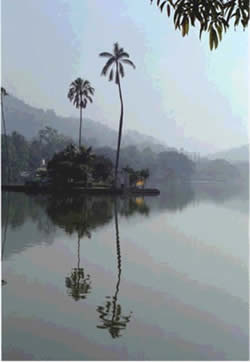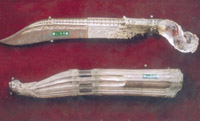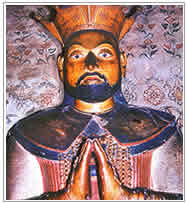Tamil Rulers of the Kandyan Kingdom
by G. Amirthalingam, London, United Kingdom
The Kandyan kingdom was the only kingdom in Sri Lanka which was never conquered by any western power. It was ruled by a line of Tamil Kings, who came from South India, for nearly eight decades.
 As King Narendrasinghe, the last Sinhalese king of Kandy, died without an heir to the throne, his wife, who was a Tamil from South India, invoked a custom that was practised in South India which grants the Queen’s family the right to claim the throne in the event of there being no legitimate claimant from the King’s side.This unprecedented move by the Queen paved the way for an unbroken line of Tamil Kings ruling Kandy, and laid the foundation for the Tamil customs and cultures to take firm root in Kandyan society. This influence is evident in every social activity of the Kandyans to this day. Tamil power in the Kandyan royal court was such; one of the Queen’s brothers was brought from South India and enthroned as King of Kandy. As King Narendrasinghe, the last Sinhalese king of Kandy, died without an heir to the throne, his wife, who was a Tamil from South India, invoked a custom that was practised in South India which grants the Queen’s family the right to claim the throne in the event of there being no legitimate claimant from the King’s side.This unprecedented move by the Queen paved the way for an unbroken line of Tamil Kings ruling Kandy, and laid the foundation for the Tamil customs and cultures to take firm root in Kandyan society. This influence is evident in every social activity of the Kandyans to this day. Tamil power in the Kandyan royal court was such; one of the Queen’s brothers was brought from South India and enthroned as King of Kandy.
There were many Sinhalese kings in the past who were married into South Indian royal families in order to extend their influence, and to protect their territory against aggression.
Tamils held high positions in the Kandyan Kingdom. The language of the court was Tamil. Hence, even the high ranking Sinhalese officials in Kandy were fluent in Tamil. The Hindu religion was given an important place along with Buddhism and none of the Tamil kings ever failed to promote and maintain Buddhism as a major religion in Kandy. The presence of Hindu temples and the procession of the Hindu deities during festive seasons were the result of Tamil influence.
The Queen’s brother ruled Kandy as Sri Vijaya Rajasinghe from 1739 to 1747. When he died without any offspring, his brother-in-law, Kirthi Sri Rajasinghe(1747 – 1782), inherited the kingdom. Kirthi Sri Rajasinghe was succeeded by his brother Rajadhi Rajasinghe (1782-1798). The last Tamil king of Kandy was an 18 year old youth by the name of Kannusamy: a relative of the royal family but not a natural heir to the throne. He was, in fact, installed on the throne by a Sinhalese chieftain called Pilimatallawe, in spite of other claimants; one of whom was the Queen’s brother, the rightful candidate by the name of Muthusamy, who was also a favourite of the British.
 The sword used by King Sri Wickrama Rajasinghe when captured by the British(Pic By Saman Sri Wedage, Daily News, 2002) The sword used by King Sri Wickrama Rajasinghe when captured by the British(Pic By Saman Sri Wedage, Daily News, 2002) |
The last king took the name of Sri Wickrama Rajasinghe and ruled from 1798 to 1815. This period was full of turmoil and uprisings and saw the end of the Kandyan kingdom. Sinhalese chieftains of Kandy, disgruntled with the king and his rule, instigated the people to rebel against the king. Furthermore, they sought help from the British to overthrow the king. They were prepared to accept a foreign power to rule over their kingdom at the cost of their independence. The king did not hesitate to crush rebellions and punish anyone who betrayed him by impaling, drowning and so on. Chieftains, who were power hungry, and the British, whose prime concern was to capture Kandy, painted a picture of the situation in Kandy and of the king’s actions that conveyed the message that the king was a tyrant and a ruthless ruler. In fact, he meted out punishments that had been in practice for centuries. Ironically, these types of punishments were common in Britain and other Western countries at that time. Fabricated stories spread through the kingdom. An internal uprising against the King and rivalry among the chieftains furnished the British with an ideal opportunity to enter the impregnable Kandyan kingdom with the help of the rebels in 1815, thereby ending the Tamil Nayakar dynasty and the sovereignty of the kingdom.
 Sri Wickama Rajasinghe Sri Wickama Rajasinghe
|
Soon after the rebels surrounded the house where the King had taken refuge. He and his wife were humiliated at the hands of the rebels; the king was assaulted, kicked and spat at, and his hands and legs were tied to a pole. His wife’s dress was torn and her jewels were snatched from her person, causing injury. British troops arrived at the scene in time and rescued the King and his family from being hurt further by the angry crowd, and brought them to Colombo via Negombo with a strong escort. The King and his family were kept in Fort in a large house overlooking Beira Lake. A Dutch dressmaker made a dress for the Queen to wear for the portrait that was painted during their stay. They lived there for almost 11 months. When they were sent back to India there was a large crowd to witness their departure. It was with great respect and honour they were treated by the British and most of the high ranking officials accompanied them to the port.
When the King and his family arrived in South India they were carried in palanquins to Vellore. In Vellore they were given a large house with servants and an allowance. Most of the items that they wanted were provided by the British. In spite of all this, they became heavily in debt due to their lavish spending on luxury items. Even though this irritated the British, they were given extra money to pay off part of their debt. Their decedents, at present, are in need of help because they were left with nothing when the King died of dropsy on the 30th of January, 1832 at the age of 52.
As mentioned earlier, Kandy was never conquered, but surrendered to the British by a convention signed on the 2nd of March 1815. Out of 11 Chieftains, who were witness to the Convention, many of them signed the Treaty in Tamil.
|
 Home
Home Archives
Archives Home
Home Archives
Archives